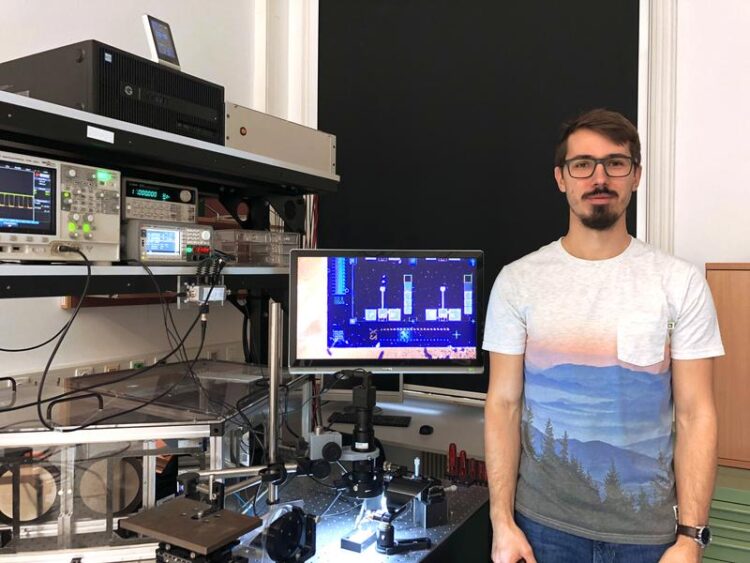Terahertz radiation source: Compact and simple

Petr Ouředník in the lab
Credit: TU Wien
A novel, simple and extremely compact radiation source for terahertz waves has been developed at TU Wien. The possible applications are manifold.
Terahertz radiation has a wavelength of typically a little less than one millimetre – a technically difficult range. Electromagnetic waves with longer wavelengths can be generated with ordinary electronic components (such as transistors) and antennas. Smaller wavelengths can be obtained with ordinary light sources, such as lasers or LEDs. However, the terahertz range in between is still a technical challenge. Yet radiation in this range can be very useful. It is needed in many areas, from material testing or airport security control to radio astronomy, and perhaps also in future telecommunication systems.
TU Wien (Vienna) has now succeeded in producing an extremely simple and compact source of terahertz radiation: An oscillator with double resonant-tunnelling diodes. Its radiation power significantly outperforms similar devices. The new technology has now been published in the scientific journal Applied Physics Letters.
Chip size instead of lab bench size
“Today, there are various ways to generate terahertz waves,” says Prof. Michael Feiginov (Institute of Electrodynamics, Microwave and Circuit Engineering, TU Wien). One can use quantum cascade lasers, for example. With those, it is possible to achieve high intensities, but they have to be cooled down to very low temperatures. Also, large, complicated photonic systems can be used, with several optical lasers whose radiation is mixed together to produce longer wavelengths. This makes it possible to produce the desired wavelengths in a very flexible way. “However, our goal was to develop a simple and extremely compact terahertz source,” Michael Feiginov emphasises. “If we want a technology to be incorporated into everyday devices in the future, then the terahertz sources must be small and function at normal room temperature.”
To do this, the team now used neither optical nor quantum cascade lasers, but simple oscillators. “Oscillators are something quite common in electrical engineering,” says Petr Ouředník (TU Vienna), the first author of the current publication. If certain electronic components, such as coils and capacitors, are coupled, then the energy flows back and forth between them, thereby generating electromagnetic radiation. “But the problem is usually the losses, which you can imagine as electric resistance,” says Petr Ouředník. “This normally ensures that the oscillations in these resonant circuits come to a standstill after a very short time.”
Quantum trick for negative resistance
However, this can be changed with quantum-physics tricks: “We use resonant-tunnelling diodes, where the current flows between two barriers as a result of tunnelling,” says Petr Ouředník. “The quantum well between the barriers is particularly narrow in our structures, so only very specific and very few electron states can exist there.” By applying a voltage, these electron states and their energies can be changed.
Normally, the current flow increases when the electrical voltage is increased – the electrical resistance indicates to what extent. In resonant-tunnelling diodes, however, the opposite effect is possible: if the voltage increases, it can happen that the electron states in the quantum well no longer match the electron states in the other parts of the structure. This means that the electrons can no longer cross over from one area to the other, and the current flow decreases instead of increasing. This means: the electrical resistance becomes negative. “A negative resistance in the oscillating circuit, however, means that the oscillating circuit does not lose its energy, it gains energy instead. The electromagnetic oscillations keep going by themselves and the external direct current is converted into terahertz radiation,” says Michael Feiginov.
From mobile phones to radio astronomy
The remarkable thing about this technology is not only the considerably high intensity of the terahertz radiation, but above all its small size: the entire structure is considerably smaller than a millimetre. It would therefore be potentially suitable to be built into compact devices such as smartphones.
“There are so many application ideas that we can’t even say today which one is the most realistic,” says Michael Feiginov. “The terahertz range is used in radio astronomy, one can use it to see through optically opaque objects, for example in security checks at the airport or even in material testing. Another exciting application are chemical sensors: different molecules can be recognised by the fact that they absorb very specific frequencies in the terahertz range. All these technologies will benefit from simple and compact terahertz sources, and that’s what we wanted to make an important contribution to.”
Journal: Applied Physics Letters
DOI: 10.1063/5.0068114
Method of Research: Experimental study
Subject of Research: Not applicable
Article Title: Double-resonant-tunneling-diode patch-antenna oscillators
Article Publication Date: 17-Dec-2021
Media Contact
Florian Aigner
Vienna University of Technology
pr@tuwien.ac.at
Office: 0043-158-801 x41027
All latest news from the category: Power and Electrical Engineering
This topic covers issues related to energy generation, conversion, transportation and consumption and how the industry is addressing the challenge of energy efficiency in general.
innovations-report provides in-depth and informative reports and articles on subjects ranging from wind energy, fuel cell technology, solar energy, geothermal energy, petroleum, gas, nuclear engineering, alternative energy and energy efficiency to fusion, hydrogen and superconductor technologies.
Newest articles

Innovative 3D printed scaffolds offer new hope for bone healing
Researchers at the Institute for Bioengineering of Catalonia have developed novel 3D printed PLA-CaP scaffolds that promote blood vessel formation, ensuring better healing and regeneration of bone tissue. Bone is…

The surprising role of gut infection in Alzheimer’s disease
ASU- and Banner Alzheimer’s Institute-led study implicates link between a common virus and the disease, which travels from the gut to the brain and may be a target for antiviral…

Molecular gardening: New enzymes discovered for protein modification pruning
How deubiquitinases USP53 and USP54 cleave long polyubiquitin chains and how the former is linked to liver disease in children. Deubiquitinases (DUBs) are enzymes used by cells to trim protein…



